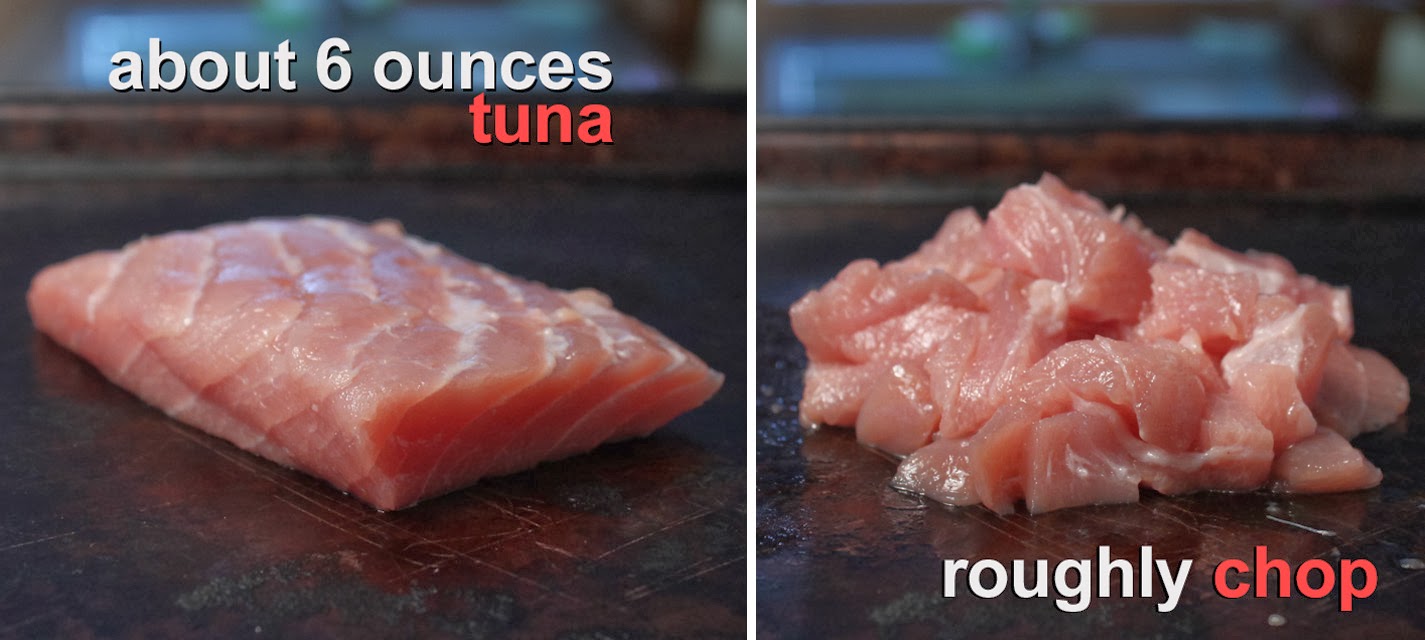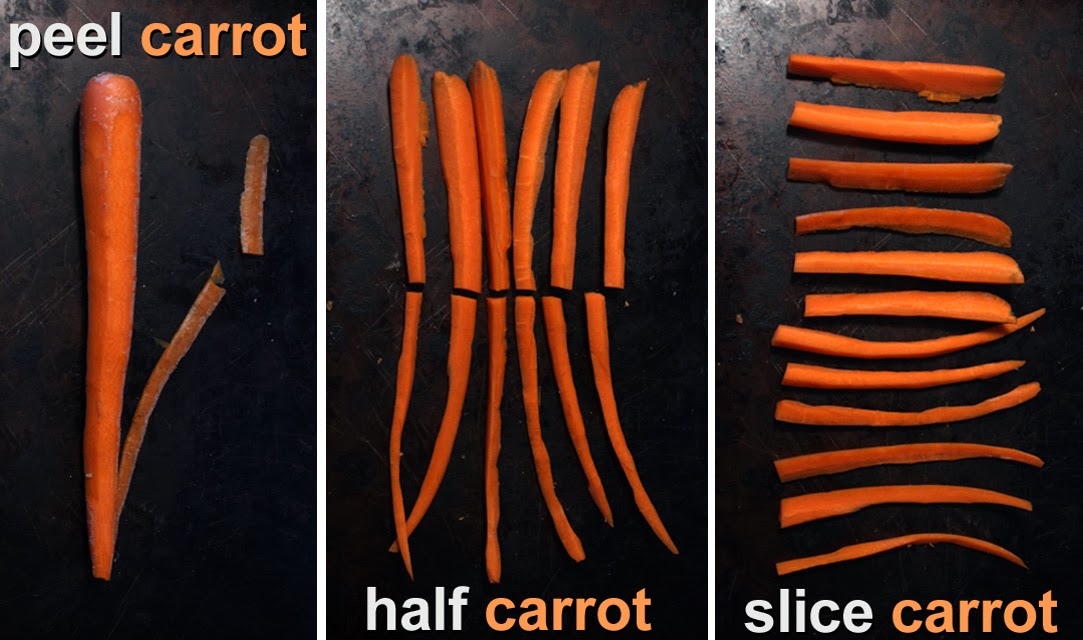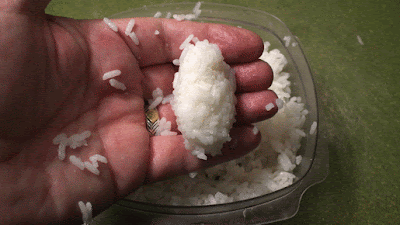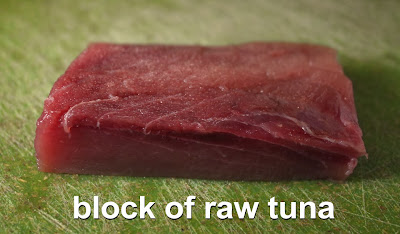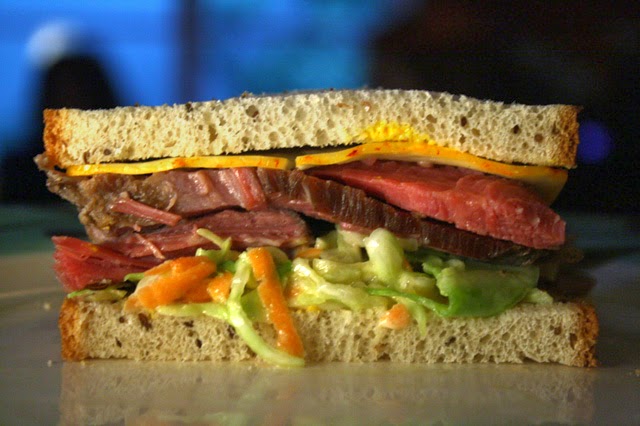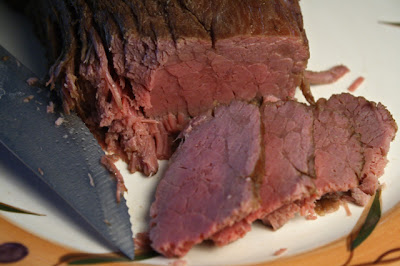When you dine at the sushi counter in a Japanese restaurant it can be intimidating -- all that precise assembling and slicing choreography.
Making a Hand Roll is like making a flatbread (or tortilla) sandwich roll. Just slice up some veggie and fish ingredients and pile it on a sheet of seaweed (known as Nori) half covered with cooked sushi rice -- then roll it into the shape of a pointy-end snow cone.
Japanese chefs work overtime on visual presentation, but a Hand Roll is more about what you put in, than how it looks.
For this Hand Roll I'm using Spicy Tuna. And Spicy Tuna is just mayo and hot sauce (usually Sriracha Spicy Chili Sauce, or an imitation brand) mixed into chopped raw tuna. But any hot sauce can be used.
(For a cheaper hand roll scroll go to the end of my blog post under Hindsight, and read about making one with imitation crab - I'll have a fake crab recipe, with photos and text, posted in a few weeks, too.)
If you made my Nigiri Tuna Sushi from the last blog post then you may have saved some tuna scraps. A hand roll is perfect for the small trims of tuna, any uneven pieces, and unattractive cuts. (When I make sushi I never throw away the fish scraps, unless it's just too stringy or chewy.)
The only tricky thing is spreading out sticky rice and rolling the Hand Roll. And even that isn't too difficult.
For handling sticky rice just dampen your hands. And for rolling, roll the loaded seaweed diagonally, and seal it with dampened fingertips -- the ingredients will hold together in a sleek black wrap.
With a hand roll the rice doesn't have to be perfect sticky sushi rice. You can use any favorite rice recipe. The sheet of dried seaweed will hold it all together.
You will need a good cut of raw fish (I get mine free from my fisherman neighbor Don, click here to see video.) For this recipe I used fatty tuna. I used a leaner cut of tuna for my Nigiri Tuna Sushi video recipe from a last week. And Click here for a list of fish commonly used for sushi.
Probably the most unusual ingredient for a Sushi Roll is dried seaweed. They come in 8 inch square thin sheets; anywhere from 10 to 30 sheets to a package. I get mine at Oriental markets, but they are now being sold in some regular chain grocery stores. If you have a Little Tokyo or Chinatown nearby, then you can find dried seaweed, for a decent price. The best price I've found is 30 sheets for $2.49 -- that's less than 10 cents per sheet! Even if you have to pay twice as much, you will surely use up the whole package trying out everything in my Sushi Recipes Video Series.
I was intimidated to try making sushi for a long time, but now I do it frequently. The main thing is to do it a few times -- with a couple of mistakes under your belt, you will get better. I have.
So do check back for more sushi recipes, including a cheap, easy-to-make, California Roll, that's made with krab, cucumber and creamy avocado.
Spicy Tuna Hand Roll- VIDEO
Play it here, video runs 2 minutes, 30 seconds.
My YouTube video link for viewing or embedding, just click here.
Ingredients for Spicy Tuna (2 to 4 rolls)
- About 6 ounces of tuna - skinless and no bones. I used fatty tuna for this recipe.
- 3 tablespoons mayo - I used light mayo. Add more or less to desired creaminess.
- 1 teaspoon Sirracha Chilli Sauce - can also use a favorite hot sauce, grated horseradish, or a pinch of ceyanne pepper. Okay to add a little at a time to reach desired spicyness.
Other Ingredients
- About 2 cups cooked Sushi Rice - for my Sushi Rice recipe, click here for text with photos, or scroll down to the end for video only.) You can use any type of cooked rice for a hand roll.
- 1-2 sheets of dried seaweed - sliced in half
- Favorite thinly sliced veggies - carrot, green onions, cucumber or avocado. For a hand roll, fill it up with any favorite sliced veggies, raw or lightly steamed.
Directions for Spicy Tuna Hand Roll
Have Sushi Rice at the ready, room temperature. To see my Sushi Rice recipe, click here.
Mix mayo and Sirracha Chilli Sauce (or your favorite hot sauce) in a bowl. Add a little hot sauce at at time and taste, to bring up to desired spicyness.
Roughly chop raw tuna into small pieces. Mix chopped tuna with spicy mayo. Cover and store in refrigerator until ready to use.
Thinly slice favorite veggies such as: carrot, green onion, cucumber and avocado. Slices can be long or short. You can use packaged shredded carrot or peel and slice your own.
For whole carrots just peel off skin and chop off ends. Split carrot in half across the middle, then split one more time lengthways. Finally slice carrot segments thinly.
For cucumbers slice in half lengthwise and spoon-out seeds. You can peel some of the cucumber or not.
For green onion slice off the green stems and give the stems one more slice lengthwise. (While the green stems are tasty they are tough to bite through, so slicing them thinly makes it easier.) You can sprinkle in some of the chopped white onion pieces too. (Discard green onion root and any wilted stems parts.)
Next, slice dried seaweed in half. It's kind of brittle so handle carefully. Please note that dried seaweed is super-obsorbant, so make sure cutting surface, your hands, and the knife are dry.
Time to bring it all together. Place halved seaweed section, lengthwise, on a dry surface. Dampen fingers and spread on a layer of Sushi Rice over about one half of the seaweed. Just enough rice to cover the surface, no need to pile it on too thick.
Now add spicy tuna on the rice-side of the seaweed. It's up to you how much fish to add - a thick or thin layer. Again, once you've made a few Hand Rolls then you will get better at figuring out the amount of rice to fish you like.
Finally seal the Hand Roll with a bead of water. When you have rolled it up moisten fingertips and wipe the seaweed end-edge and press it together. It should seal up and stick together easily.
The end result will look like an ice cream cone with the pointy end. You can make Hand Rolls one at a time or all at once.
Hindsight
If you don't like raw carrot, it's okay to seam for a few minutes to desired softness. This pertains to any veggie you like to use.
It's up to you how much veggies, rice and fish you add to each roll. You can be generous or skimpy doling out the spicy fish.
I know sushi grade raw fish is way expensive. A cheap seafood substitution is krab. You've seen the small frozen packages in seafood deli cases, and even laid out with fresh fish. It's tasty and you don't have to pry it out of a shell. Sometime the quality is suspect. It can be a little dried out from freezing for too long. An easy way to reconstitute, after defrosting, is to sprinkle on a little water, loosely cover, and do a 30 second micorwave (take out pieces as they get warm and soft, and continue to zap in 10 second increments, if krab pieces are still cool.) The krab will soften and plump up perfectly. Finally do a rough chop and mix it with the some Spicy Mayo.
Hand Rolls work well with imperfect rice, too. Since the rice is in a wrap, you can use reheated cooked rice from another day, or even defrosted from the freezer. Just make sure the rice is heated to room temperature.
You can easily use brown rice, just follow my Sushi Rice directions. And after the rice is cooked, let it set for an extra 10 minutes. Brown rice is toothsome with an extra nutty flavor, and more nutritious.
Sushi Rice Recipe Video









